Apple's introduction of M3 didn't just launch one new chip, but a trio instead. Here are the differences between the M3, the M3 Pro, and the M3 Max.
The "Scary Fast" Apple Event introduced new MacBook Pro and 24-inch iMac models, as well as the launch of a new chip generation. After M1 and M2, Apple has moved on to the M3 generation of Apple Silicon.
However, rather than the usual launch of the entry-level M3 on its own, Apple instead decided to bring out three chips within the range. The M3 was joined by the M3 Pro and the M3 Max, chip variants that typically arrive later in the generation.
As is typical for Apple, it declared the M3 collection to be faster than its predecessors, with additional features introduced as part of the redesign. All of these are made using a 3-nanometer process that enables a more densely-packed chip, as well as benefits in power usage and other efficiencies.
Here's how the trio of M3 chips differ from each other in the range.
Specifications
| Specifications | M3 | M3 Pro | M3 Max |
|---|---|---|---|
| CPU Cores (Total) | 8 | 11 or 12 | 14 or 16 |
| CPU Performance Cores | 4 | 5 or 6 | 10 or 12 |
| CPU Efficiency Cores | 4 | 6 | 4 |
| GPU Cores | 10 | 14 or 18 | 30 or 40 |
| Neural Engine Cores | 16 | 16 | 16 |
| Transistors (B) | 25 | 37 | 92 |
| Foundry process | 3nm | 3nm | 3nm |
| Unified Memory Capacities | 8GB, 16GB, 24GB | 18GB, 36GB | 36GB (14-core), 48GB (16-core), 64GB (16-core), 96GB (14-core), 128GB (16-core) |
| Memory Bandwidth | 100GB/s | 150GB/s | 300GB/s (14-core), 400GB/s (16-core) |
| Media Engine | Video decode engine, video encode engine, ProRes encode and decode engine, AV1 decode | Video decode engine, Video encode engine, ProRes encode and decode engine, AV1 decode | Video decode engine, 2 Video encode engines, 2 ProRes encode and decode engines, AV1 decode |
M3 vs M3 Pro vs M3 Max - CPU
The core of the chip, the central processing unit handles the main workload. It is an essential component, and while they are basically made the same way, there are variations in how they function.
This is chiefly down to the amount of cores that each uses, and how those cores are set up, but there are other differences as well to bear in mind. Elements such as memory bandwidth can help bump up performance, for example.
The entry-level M3 has eight CPU cores in total, with an even split between performance cores and efficiency cores. The performance cores can handle tough tasks quickly, while the efficiency cores provide less computing grunt at a typically lower clock speed, but also in a far more power-efficient way than the performance cores.
The M3 Pro goes a stage further, in two forms. The 11-core version has five performance and six efficiency cores, while the 12-core has six performance and six efficiency cores.
This is a departure from the M2 Pro, which had four efficiency cores and either six or eight performance cores. This does mean there are proportionately fewer performance cores to use in the M3 Pro versus efficiency.
This is a philosophical difference versus what it did with M1 Pro and M2 Pro. We theorize that this is related to maximizing the battery life in the M3 Pro, instead of delivering maximum performance — which is what the M3 Max is for.
The M3 Max has the highest core counts, with 14-core and 16-core options available. However, instead of an even split as the other two offer, Apple instead leans the CPU towards performance.
As such, the M3 Max has four efficiency cores, and a choice of 10 or 12 performance cores, depending on the variant.
These core counts also play into the physical size of the chips, with the M3 being the physically smallest and M3 Max the largest.
In terms of transistors used for the entire chip, the M3 has 25 billion, while the M3 Pro uses 37 billion, and the M3 Max employs a mammoth 92 billion transistors. For reference, the M2 generation uses 25 billion, 40 billion, and 67 billion respectively.
When it comes to what performance users will get, Apple generalizes the performance cores as being about 15% faster than the M2 generation and 30% faster than M1. The efficiency cores in M3 are characterized as 30% faster than M2, and 50% faster than M1.
One other major area is memory, but while we will discuss capacity later, it's pertinent to raise memory bandwidth here. Since accessing the Unified Memory at speed is crucial to performance, the higher the speed is generally better for processing.
In the M2 generation, Apple included 100GB/s of memory bandwidth, with the M2 Pro doubling it to 200GB/s, and M2 Max doubling again to 400GB/s.
For M3, this isn't quite the case. While the M3 again uses 100GB/s, the M3 Pro instead opts for a smaller increase to 150GB/s. For the M3 Max, the 14-core CPU version has 300GB/s of memory bandwidth, while the 16-core has 400GB/s
It is unknown why Apple decided to make this change, but it does mean that the M3 series does have lower memory bandwidth than counterparts in the preceding generation for some chips.
In terms of benchmarks, the Geekbench single-core test puts the M3 family at around 3,100 points, which makes sense since Apple runs the performance cores at 4.05GHz across the board. By contrast, an M2 Ultra chip manages 2,800 under the same test, thanks to its base clock speed of 3.5GHz.
Over on multi-core, it's unsurprising to see that the M3 Max outpaces the M3 Pro, which does better than the M3.
One of the takeaways is that the M3 Pro could've done better if Apple had included more performance cores instead of leaning more on efficiency cores.
The other is that the M3 Max is a beastly chip for multi-core processing. According to Geekbench, its 16-core variant can go practically toe-to-toe with the M2 Ultra, which is effectively two M2 Max chips attached to each other.
If nothing else, the M3 Max chip should give those eyeing an M2 Ultra something to seriously consider. We'll be talking more about this in our review of the M3 Max MacBook Pro.
M3 vs M3 Pro vs M3 Max - GPU
As usual for Apple Silicon upgrades, Apple is including a newly-designed graphics architecture in its chips, and with higher core counts too.
For the M3, users have no choice but to stick with a 10-core GPU. On M3 Pro, the 11-core CPU includes a 14-core GPU, while the 12-core CPU is bundled with a 12-core GPU.
With the M3 Max, Apple includes either 30 cores or 40 cores on the GPU, depending on whether the user goes for a 14-core or 16-core GPU.
Naturally, the more cores, the higher the potential performance of the chip in graphics performance. But again, there's more at play here than simply counting cores.
This time around, Apple says its GPU architecture includes hardware-accelerated ray tracing and mesh shading, which will help improve the appearance of highly graphical applications, like games.
More important is the introduction of Dynamic Caching, a system that "allocates the use of local memory in hardware in real time," according to Apple. Given that Unified Memory applies to the CPU, the GPU, and other components, this would give the GPU more dedicated space to play with than if it had to share everything.
Apple claims that the rendering speeds on M3 are up to 2.5 times faster than the M1 Max's GPU. It's also proposed that the M3 GPU can provide the same performance as an M1 GPU while using nearly half the power.
One thing that hasn't changed much is external display support. In the case of the MacBook Pro, the M3 can handle only one external 6K 60Hz display alongside the built-in one, matching the M2.
The M3 Pro can deal with up to two external 6K 60Hz displays, or one 6K 60Hz screen and another 4K 144Hz over HDMI. For one external screen, it can be an 8K 60Hz display, or a 4K 240Hz monitor.
The m3 Max can go up to four external displays, including three 6K 60Hz and one 4K 144Hz screen. At three displays, that can be two 6K 60Hz panels and one 8K 60Hz or 4K 240Hz screen.
M3 vs M3 Pro vs M3 Max - Memory
While the bandwidth of Unified Memory is important, capacity is arguably more crucial. For the M3 generation, Apple has taken a step forward, but stumbles a bit with the implementation.
The M3 can support capacities of 8GB, 16GB, and 24GB of Unified memory. This is unchanged from what is offered by the M2.
While the M2 Pro could deal with 16GB to 32GB of memory, the M3 Pro goes a little bit further in handling 18GB and 36GB capacities.
The most important, and confusing, memory change is for the M3 Max. The M2 Max was capable of dealing with 96GB of memory, but the M3 Max can do a lot more, at up to 128GB.
The headache is in understanding how Apple offers its capacities for the M3 Max.
For the 14-core CPU version, the capacities are 36GB and 96GB. However, the 16-core CPU edition, the top-spec model, starts at 48GB and goes up to 64GB, then to 128GB.
Upping the potential memory on the M3 Max to 128GB is a great option for power users who actually need it. That is if you're not bamboozled by the state of M3 Max memory options.
M3 vs M3 Pro vs M3 Max - Neural Engine
A common sight among Apple's Mac and mobile chips, the Neural Engine is made to handle machine learning tasks better than the CPU alone. The Neural Engine is the same across the entire generation, with the exception of Ultra models.
For the M3 generation, it's still a 16-core component, but this time it is capable of 18 trillion operations per second. This is an increase from the 15.8 trillion operations per second of the M2 counterparts.
Apple doesn't specifically say how much faster than the M2 the M3 Neural Engine is, but it claims a 60% increase in speed over the M1 version. For the M2 Neural Engine, Apple said it was faster than M1's Neural Engine by 40%.
M3 vs M3 Pro vs M3 Max - Media Engine
Since the introduction of the M1 Pro and M1 Max, Apple has included an element called the Media Engine. Rather than leaving the CPU to handle video encoding, the Media Engine provides hardware video encoding and decoding, making it a valued component for creative professionals.
Much like the M2 Media Engine, there's a slight difference in what is offered when you get to the M3 Max chip.
The Media Engine in the M3 and M3 Pro includes one each of video decode and encode engines, as well as ProRes encode and decode engines. The M3 Max adds another video encode engine and doubles up the ProRes encode and decode engines.
New for M3 is the addition of AV1 decoding. This is on top of the existing functionality of dealing with H.264, HEVC, ProRes, and ProRes RAW footage.
Newer and more expensive is, usually, better
As was the case for the M1 and M2 generations, there are a lot of performance differences when it comes to the M3 Apple Silicon range. As Apple's latest generation, it's certainly more performative than the M2 and the M1 before it.
As you would expect, going up to higher tiers offers more performance, especially in multi-core performance. After all, if you're spending more money, you'd expect to get more bang for your buck.
The odd exception this year is the M3 Pro, especially with its core count split. By evening the split out, it minimizes the advantage in having more cores available for performance-related tasks.
Arguably it shouldn't need as many cores for pedestrian tasks the economical cores will be used for. But, it's still there as an option for users who want more performance than the base-level chip, without paying out a lot for the highest-performing bit of Apple Silicon.
Most surprising is the raw performance of the M3 Max against the M2 Ultra, which is effectively two M2 Max chips stuck together and doubling the resources.
If the M3 Max is that powerful on its own, an M3 Ultra following the existing pattern could be an exciting prospect indeed.
 Malcolm Owen
Malcolm Owen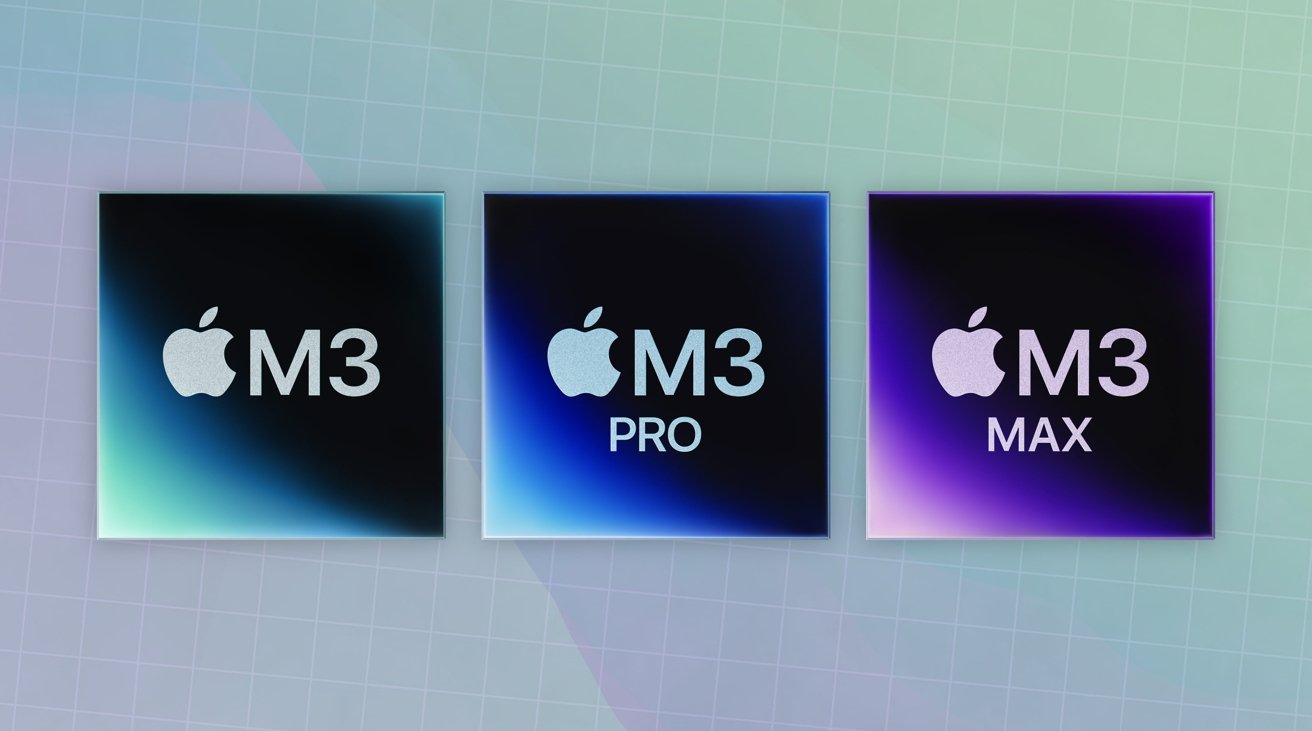
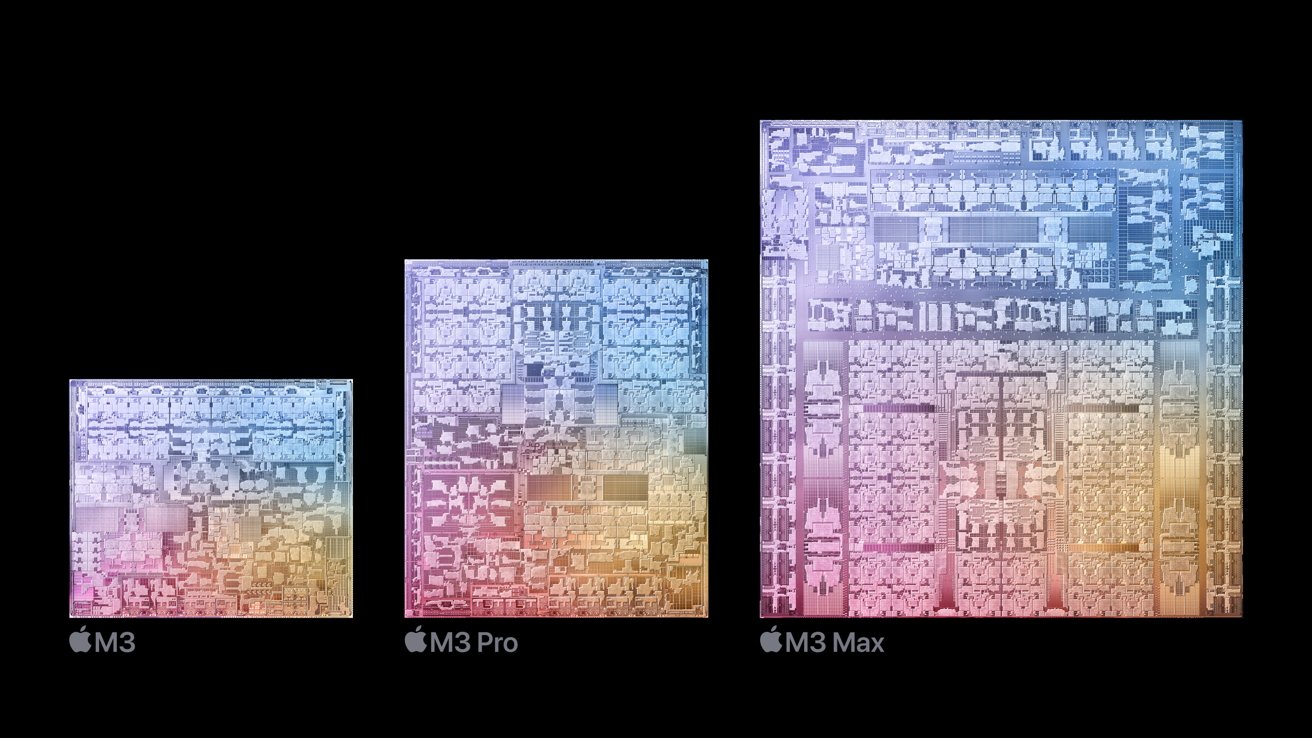
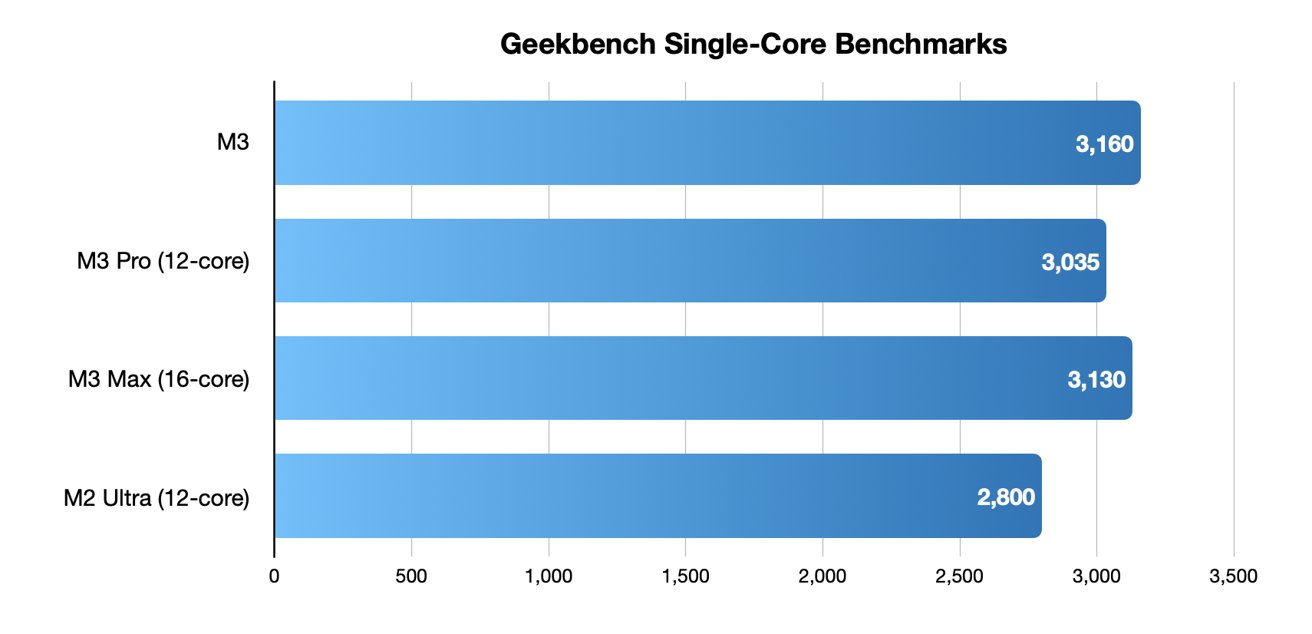
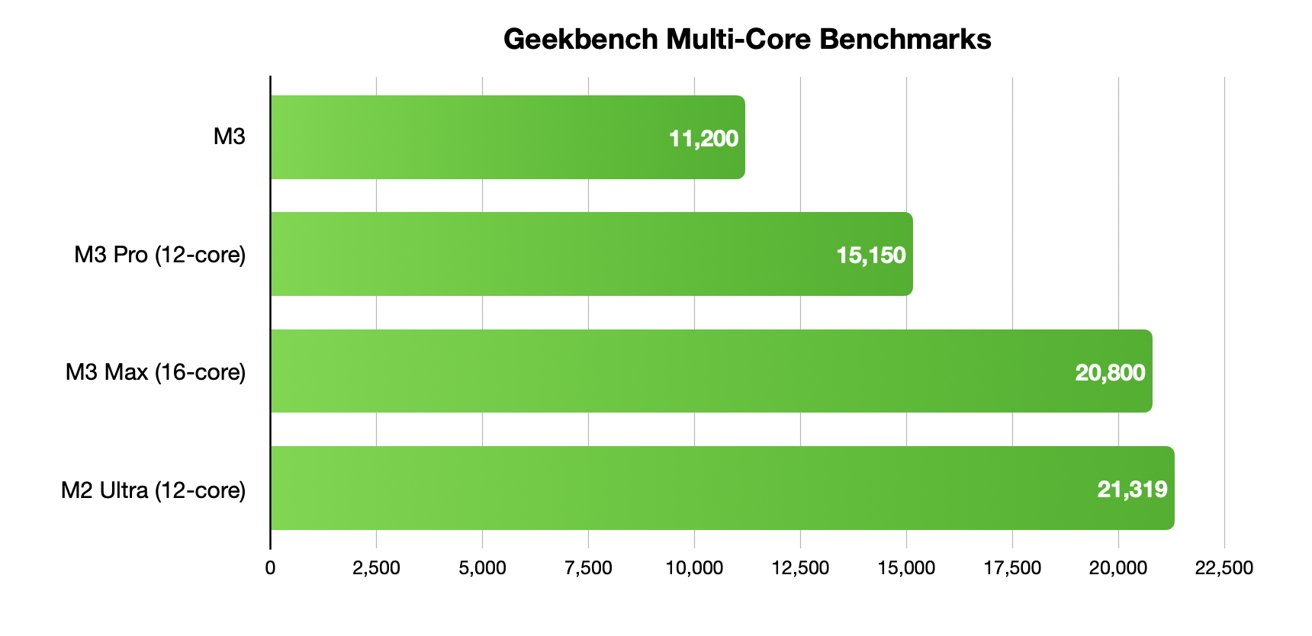
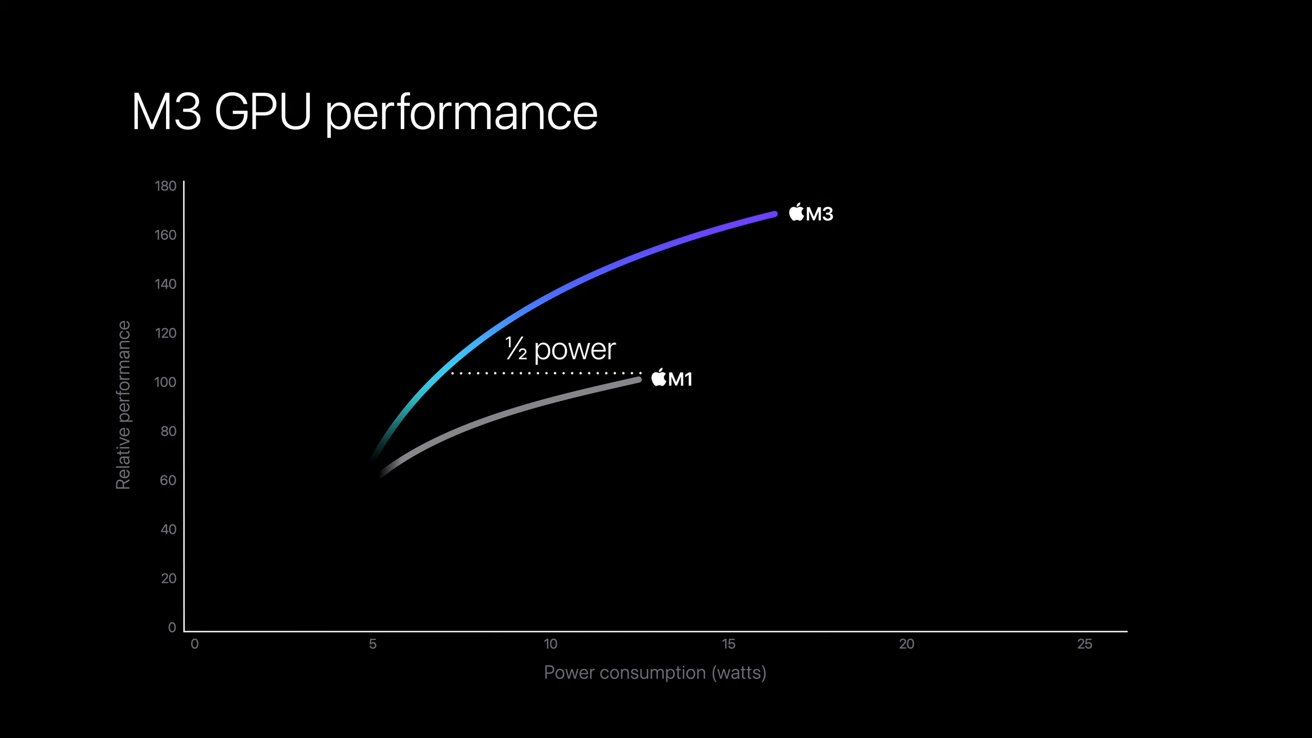
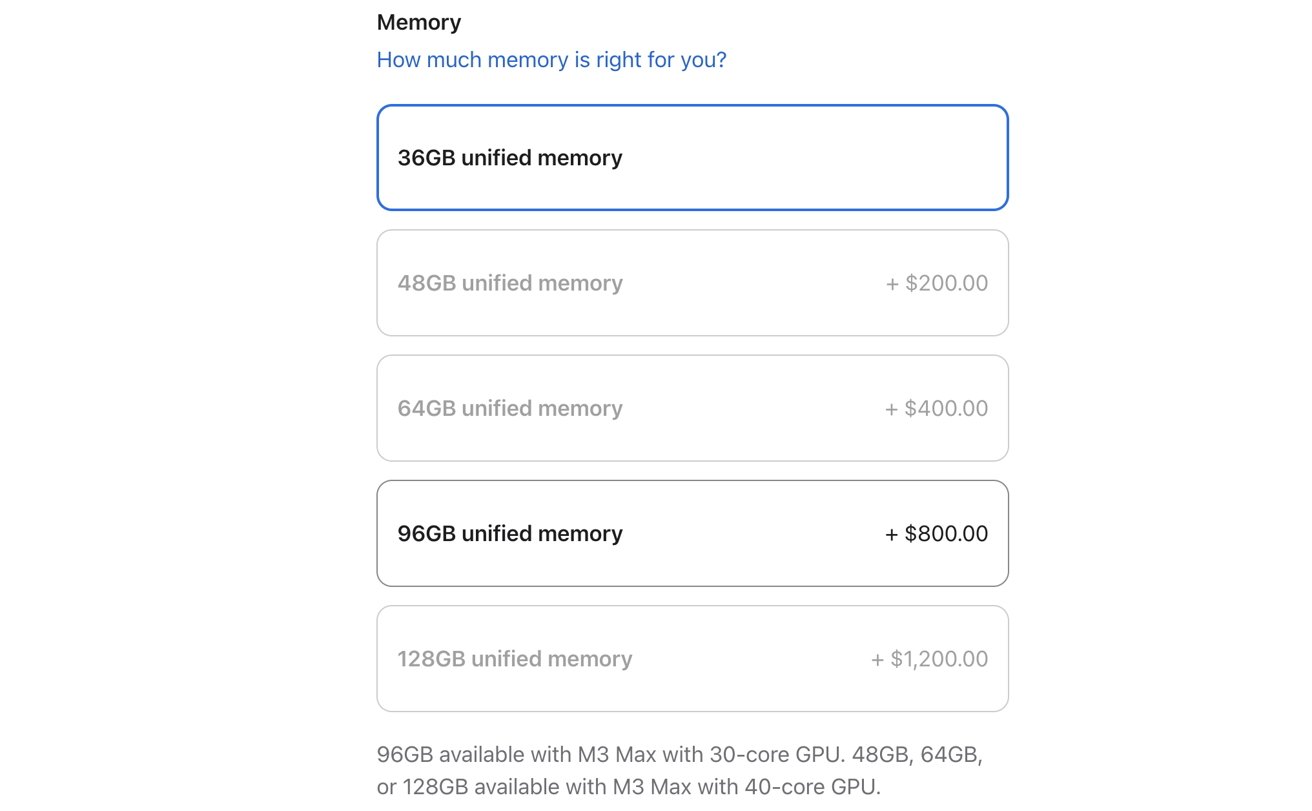
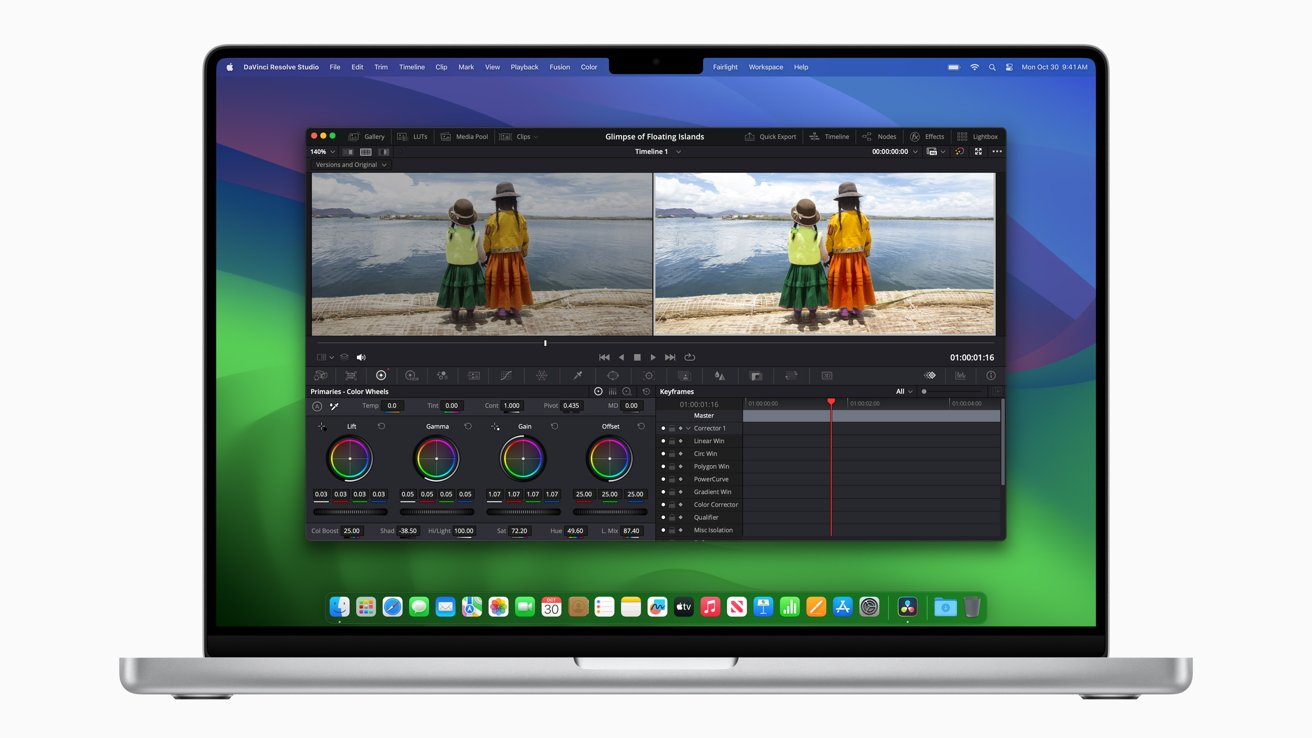







-m.jpg)






 Charles Martin
Charles Martin
 Marko Zivkovic
Marko Zivkovic
 Andrew Orr
Andrew Orr
 Amber Neely
Amber Neely

 William Gallagher and Mike Wuerthele
William Gallagher and Mike Wuerthele









8 Comments
I am happy with my Studio M2 Ultra and Apple Studio display for now. I suspect my next Mac replacement will be either the Studion M3 Ultra when it drops or perhaps the M4 Studio Ultra the year after. The Apple Silicon is good but currently lags the PC i9 and RTX Nvidia machine I have in AI rendering quite a bit. I hope the M3 and later close that gap at the high end. Meanwhile, it would be nice if there was a way to render across more than one Apple Silicon Mac; I have a couple of spare M1 machines.
The label in the chart for the M2 Ultra says it is 12-core. That should be 24-core, right?
And the M3 Pro GB6 numbers stems from 1 GB6 result?
I'm curious to see what the cost will be to upgrade a Mac mini from M3 to M3 Pro, holding all else as constant as possible. Right now, the cost of going from M2 to M2 Pro is $300. Since the performance gain of going from M3 to M3 Pro is smaller than the gain in going from M2 to M2 Pro, the cost of the upgrade should be less, too.